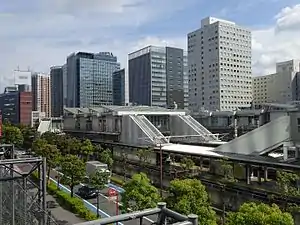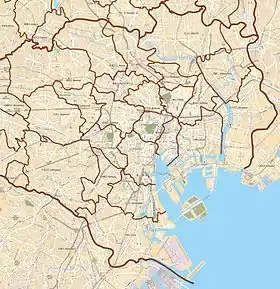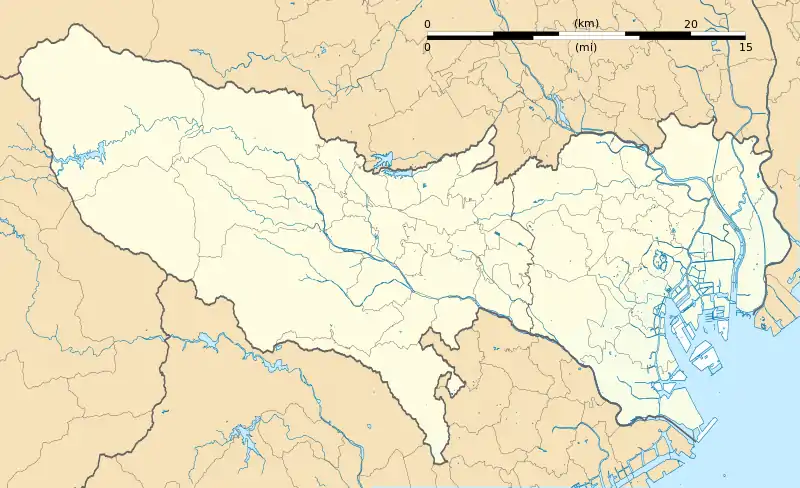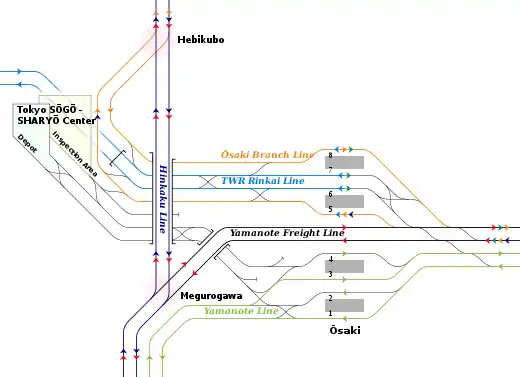Ōsaki Station
Ōsaki Station (大崎駅, Ōsaki-eki) is a railway station in Shinagawa, Tokyo, Japan, jointly operated by East Japan Railway Company (JR East) and Tokyo Waterfront Area Rapid Transit (TWR).[1][2]
OSKJY24JS17JA08 R08 Ōsaki Station 大崎駅 | |
|---|---|
 Ōsaki Station in 2016 | |
| Location | 1-21-4 Ōsaki, Shinagawa-ku, Tokyo Japan |
| Operated by | |
| Line(s) |
|
| History | |
| Opened | 25 February 1901 |
| Passengers | |
| JR East, FY2013 | 143,397 daily |
| Location | |
 Ōsaki Station Location within Special wards of Tokyo  Ōsaki Station Ōsaki Station (Tokyo)  Ōsaki Station Ōsaki Station (Japan) | |
Lines
Ōsaki Station is served by the following JR East lines.
- Saikyō Line
- Shōnan-Shinjuku Line
- Yamanote Line
It also forms the western starting point of the TWR Rinkai Line to Shin-Kiba. Most Saikyō Line trains operate through to Shin-Kiba on the Rinkai Line.
Station layout

The station has four island platforms serving eight tracks. Platforms 1 to 4 are for the Yamanote Line, and 5 to 8 are shared by the Saikyō Line, the Shōnan-Shinjuku Line, and the Rinkai Line. Ōsaki is one of the stations on the Yamanote Line loop where trains are put into and taken out of service. It therefore has four tracks (two in each direction) for the Yamanote Line so as not to interfere with continuing trains (trains go several rounds before being taken out). Chest-high platform edge doors were introduced on the Yamanote Line platforms from 22 December 2012.[3]
There are two sets of ticket barriers: the "north" and "south" gates. The north gate provides access to the east and west exits, while the south gate provides access to the new east and new west exits.
Unlike most other stations with service from multiple different transport companies, at Ōsaki the Rinkai line and JR services are behind the same fare gates, and it is possible to change between JR and Rinkai lines without exiting and re-entering. Passengers using Suica or another IC card will be charged the combined fare when they exit. Passengers holding a Japan Rail Pass and transferring onto the Rinkai line, which does not accept the pass, will need to pay the Rinkai line fare when they exit at their Rinkai line destination. A similar arrangement applies to passengers travelling through from the Saikyō line to Oimachi or another Rinkai line destination.
Platforms
| 1-2 | JY Yamanote Line | Anti-clockwise for Shinagawa and Tokyo |
| 3-4 | JY Yamanote Line | Clockwise for Shibuya, Shinjuku, and Ikebukuro |
| 5 | JS Shōnan-Shinjuku Line | for Musashi-Kosugi, Yokohama, Ōfuna, Odawara, and Zushi |
| ■ Through to Sōtetsu Shin-Yokohama Line | for Musashi-Kosugi, Hazawa yokohama-kokudai Sotetsu Line for Nishiya and Ebina | |
| R Rinkai Line | for Tokyo Teleport and Shin-Kiba | |
| 6-7 | JA Saikyō Line | for Shinjuku, Ikebukuro, Ōmiya and Kawagoe |
| R Rinkai Line | for Tokyo Teleport and Shin-Kiba | |
| 8 | JA Saikyō Line | for Shinjuku, Ikebukuro, Ōmiya and Kawagoe |
| JS Shōnan-Shinjuku Line | for Shinjuku, Ōmiya, Takasaki and Utsunomiya |
Facilities
The station has a "Midori no Madoguchi" staffed ticket office. Toilet facilities are located inside the ticket barriers, close to the north gate.
| Tōkaidō Main Line (Hinkaku Line) to Yokohama | ||
| Rinkai Line to Shin-Kiba |
 |
Yamanote Line to Ikebukuro |
| Yamanote Line to Shinagawa Tōkaidō Main Line (Hinkaku Line) to Shinagawa |
Adjacent stations
| ← | Service | → | ||
|---|---|---|---|---|
| Yamanote Line JY24 | ||||
| Shinagawa SGWJY25 |
- | Gotanda JY23 | ||
| Shōnan-Shinjuku Line JS17 | ||||
| Musashi-Kosugi MKGJS15 |
Special Rapid | Shibuya SBYJS19 | ||
| Musashi-Kosugi MKGJS15 |
Rapid | Ebisu EBSJS18 | ||
| Nishi-Ōi JS16 | Local | Ebisu EBSJS18 | ||
| Saikyō Line JA08 | ||||
| TWR Rinkai Line R08 | ||||
| Ōimachi R07 | Commuter rapid | Ebisu EBSJA09 | ||
| Ōimachi R07 | Rapid | Ebisu EBSJA09 | ||
| Ōimachi R07 | Local | Ebisu EBSJA09 | ||
| Nishi-Oi JS16 | Sotetsu JR Link Line services | Ebisu EBSJA09 | ||
History
The station opened on February 25, 1901 as a station of Nippon Railway, which was nationalized in 1906. After serving the Yamanote Line for a century, on December 1, 2002 new platforms for the Saikyō Line, the Rinkai Line and the Shōnan-Shinjuku Line opened on the west side of the station.
Passenger statistics
In fiscal 2013, the JR East station was used by an average of 143,397 passengers daily (boarding passengers only), making it the eighteenth-busiest station operated by JR East.[5] In fiscal 2013, the TWR station was used by an average of 58,041 people daily (boarding passengers only), making it the busiest station operated by TWR.[6] The average boarding passenger figures for previous years are as shown below.
| Fiscal year | JR East | TWR |
|---|---|---|
| 2000 | 57,101[7] | |
| 2005 | 93,709[8] | |
| 2010 | 126,436[9] | |
| 2011 | 127,838[10] | 49,835[6] |
| 2012 | 138,311[11] | 55,666[6] |
| 2013 | 143,397[5] | 58,041[6] |
Surrounding Area
Sega's headquarters are located near this station at the nearby Sumitomo Fudosan Osaki Garden Tower.
See also
References
- 各駅情報(大崎駅) [Station Information: Ōsaki Station] (in Japanese). Japan: East Japan Railway Company. Retrieved 8 November 2012.
- りんかい線 大崎駅 [Rinkai Line: Ōsaki Station] (in Japanese). Japan: Tokyo Waterfront Area Rapid Transit Inc. Retrieved 8 November 2012.
- 山手線大崎駅で可動式ホーム柵の使用開始 [Platform edge doors introduced at Yamanote Line Osaki Station]. Japan Railfan Magazine Online (in Japanese). Japan: Koyusha Co., Ltd. 23 December 2012. Retrieved 24 December 2012.
- 短絡線ミステリー7 [Spur Line Mysteries 7]. Japan Railfan Magazine (in Japanese). No. 513. Koyusha Co., Ltd. January 2004. p. 21.
- 各駅の乗車人員 (2013年度) [Station passenger figures (Fiscal 2013)] (in Japanese). Japan: East Japan Railway Company. Retrieved 2 September 2014.
- りんかい線について [Rinkai Line FAQ] (in Japanese). Japan: Tokyo Waterfront Area Rapid Transit Inc. Retrieved 2 September 2014.
- 各駅の乗車人員 (2000年度) [Station passenger figures (Fiscal 2000)] (in Japanese). Japan: East Japan Railway Company. Retrieved 8 November 2012.
- 各駅の乗車人員 (2005年度) [Station passenger figures (Fiscal 2005)] (in Japanese). Japan: East Japan Railway Company. Retrieved 8 November 2012.
- 各駅の乗車人員 (2010年度) [Station passenger figures (Fiscal 2010)] (in Japanese). Japan: East Japan Railway Company. Retrieved 8 November 2012.
- 各駅の乗車人員 (2011年度) [Station passenger figures (Fiscal 2011)] (in Japanese). Japan: East Japan Railway Company. Retrieved 8 November 2012.
- 各駅の乗車人員 (2012年度) [Station passenger figures (Fiscal 2012)] (in Japanese). Japan: East Japan Railway Company. Retrieved 2 September 2014.
External links
| Wikimedia Commons has media related to Ōsaki Station. |
- Ōsaki Station information (JR East) (in Japanese)
- Ōsaki Station information (TWR) (in Japanese)